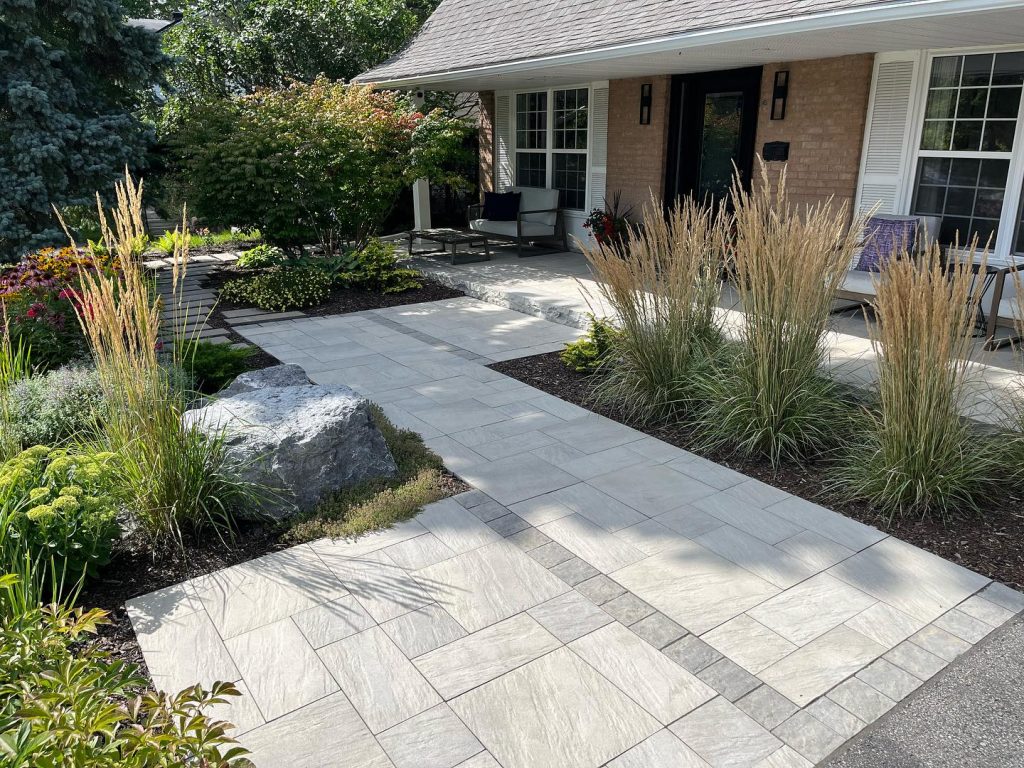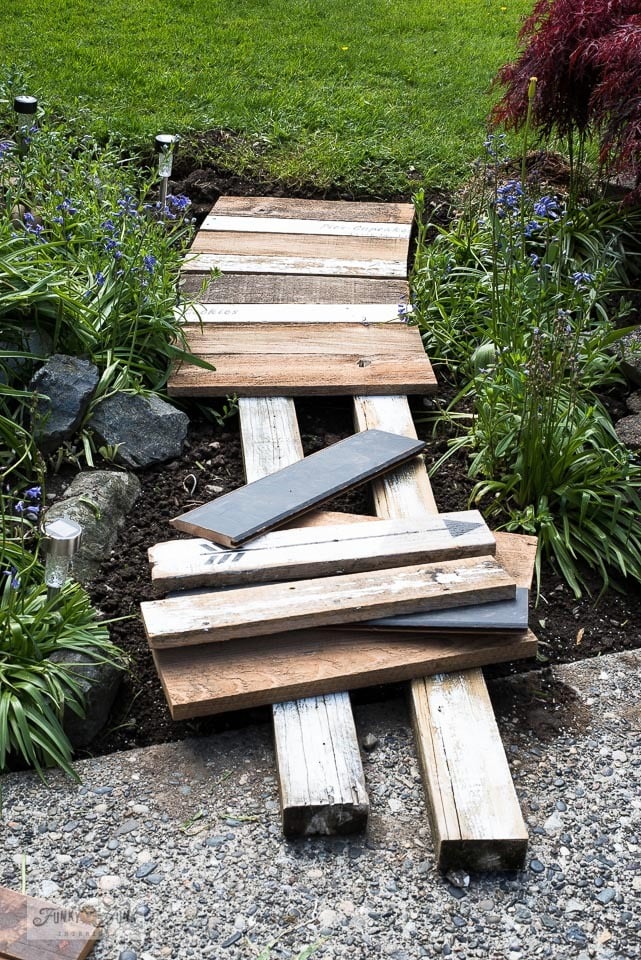Creating a beautiful and functional walkway in your yard doesn’t have to cost a fortune. With a little creativity, effort, and some affordable materials, you can create a charming path that enhances your outdoor living space. Whether you’re looking for something rustic, modern, or whimsical, these DIY cheap walkway ideas are perfect for transforming your garden, backyard, or porch area.
In this listicle, we’ll guide you through 17 budget-friendly walkway ideas that you can easily tackle yourself. Each idea is designed to suit a variety of tastes and outdoor spaces, from small garden paths to expansive backyard strollways. Let’s dive in!
1. Gravel Walkway for a Rustic Feel

A gravel walkway is a classic and affordable option that works beautifully in both rustic and modern landscapes. The best part? Gravel comes in a variety of sizes and colors, so you can customize the look to fit your style. Whether you go with crushed stone, pea gravel, or even larger decorative rocks, gravel is an easy material to work with.
To create your gravel walkway, start by laying down landscape fabric to prevent weeds. Then, outline the shape of your walkway using a garden hose or stakes and string. Once you’re happy with the path’s shape, spread a layer of gravel over the fabric, leveling it out with a rake. For a polished finish, add stone edging to keep the gravel contained. This simple and low-cost project is perfect for anyone looking to add a natural element to their outdoor space.
2. Brick or Paver Stepping Stones

For a slightly more structured look, consider using bricks or pavers to create a stepping stone pathway. This style adds a touch of elegance and works well in a variety of settings. Bricks are an affordable material, and you can often find discounted or surplus bricks at local hardware stores or online marketplaces.
To make a brick or paver walkway, start by digging a shallow trench along the path. Lay down a base of sand or gravel, and then arrange the bricks or pavers in your desired pattern. You can create a simple grid pattern or a more intricate design with diagonal lines or a herringbone effect. This project is not only cost-effective but also provides a durable, long-lasting surface for your walkway.
3. Wood Plank Pathway

Wooden planks offer a warm, natural look that complements garden settings beautifully. You can use reclaimed wood for an eco-friendly, budget-friendly solution. Simply cut the wood into long planks and lay them directly on the ground, leaving a small gap between each plank for drainage. For added stability, anchor the planks by placing them into the soil or using metal spikes.
If you’re looking for a more polished look, consider sanding and staining the wood to bring out the natural grains. A wood plank walkway works best in areas with low foot traffic, as wood can wear down over time, but it’s perfect for creating a whimsical, rustic vibe in your garden.
4. DIY Concrete Stepping Stones
:max_bytes(150000):strip_icc()/Snapinsta.app_395509201_18392967970006214_1222535030299070147_n_1080-1fb071b4933b44e2804cf82e65d0ff68.jpg)
For a more modern and customizable look, try making your own concrete stepping stones. This DIY project is simple to execute and allows you to shape the stones however you like. All you need is concrete mix, a mold (you can use plastic containers, silicone baking molds, or pre-made stepping stone molds), and some optional decorations like pebbles, glass beads, or tiles.
Start by mixing the concrete according to the package instructions, then pour it into your mold. While the concrete is still wet, you can embed your decorative items for added visual interest. Once the stones have set and cured, place them along your chosen path, adjusting the spacing to your preference. This option offers both style and durability, making it ideal for high-traffic areas.
5. Mulch Pathway for Soft, Natural Appeal
Source
Mulch is an affordable and easy way to create a soft, natural-looking walkway. It’s an especially great option for garden paths or areas where you want a more organic, rustic feel. Mulch also helps retain moisture in the soil, making it a great choice for garden walkways.
To create a mulch walkway, start by laying down landscape fabric to prevent weeds from sprouting through. Then, simply spread a thick layer of mulch over the fabric, ensuring it’s evenly distributed. You can use bark, wood chips, or even pine needles, depending on the look you want to achieve. For extra detail, consider adding stepping stones or small rocks to break up the mulch and guide the way.
6. River Rock Pathway for a Sleek Look
Source
River rocks are another excellent option for creating a sleek and visually appealing walkway. These smooth, rounded stones add texture and elegance to any outdoor space. You can use river rocks alone or combine them with other materials like gravel or pavers for a more layered design.
To create a river rock pathway, start by preparing the ground with landscape fabric. Then, simply pour a layer of river rocks over the fabric, spreading them evenly to form the walkway. For a more refined look, you can create borders with bricks or wooden edging. This type of walkway is both beautiful and functional, providing a low-maintenance path that complements modern landscaping styles.
7. Mosaic Tile Pathway for a Colorful Statement
Source
If you’re looking to add a splash of color and creativity to your garden, a mosaic tile walkway is a fantastic DIY project. You can use leftover or broken tiles from previous projects, which makes this an affordable option. You can mix and match colors, patterns, and shapes to create a truly unique and vibrant path.
Begin by preparing the surface of the walkway with sand or gravel, and then arrange the tiles in a mosaic pattern. Use a thin layer of mortar to secure the tiles in place, and once they’re set, fill the gaps between them with grout. This colorful walkway will not only serve as a functional path but also as a work of art that brightens up your outdoor space.
8. Sandstone Flagstone Pathway
Source
Sandstone flagstones create a classic, timeless walkway with a natural, earthy feel. These flat stones are easy to work with and can be found at most home improvement stores. They’re perfect for creating a more traditional or Mediterranean-inspired garden path.
To create a sandstone flagstone walkway, start by marking out your path and digging a shallow trench. Lay a base of sand or gravel to ensure proper drainage. Then, arrange the flagstones along the path, leaving small gaps between them to create a casual, informal look. Sand or moss can be used to fill the gaps for added texture and interest.
9. Stepping Stones with Moss Between Them
Source
For a more enchanted, forest-like feel, try placing stepping stones with moss growing between them. This DIY project combines the durability of stepping stones with the lush, green appeal of moss, making it perfect for a natural garden setting.
Start by placing the stepping stones along your desired path, ensuring they’re evenly spaced. Between the stones, plant moss or a mix of moss and ground cover plants. Over time, the moss will grow and spread, softening the path and adding an extra layer of charm. This walkway idea works best in shaded or partially shaded areas where moss will thrive.
10. Stepping Stones and Grass Pathway
Source
A combination of stepping stones and grass is another simple and affordable way to create a charming walkway. The grass between the stones will help soften the look while providing a natural, easy-to-maintain path. This type of walkway works especially well in garden spaces or areas where you want a lush, green feel.
Begin by laying your stepping stones in the desired pattern, ensuring there’s enough space between each one for grass to grow. Fill in the gaps with soil, then sow grass seed or plant ground cover plants. Water the grass regularly, and soon you’ll have a beautiful, green path that blends seamlessly with your garden.
11. Concrete and Wood Walkway
Source
For a modern and stylish approach, combine the sleekness of concrete with the natural warmth of wood. This hybrid pathway works well in contemporary or rustic gardens, offering the best of both worlds. Concrete provides durability and structure, while the wood adds an earthy, organic touch.
To create this walkway, begin by laying a concrete foundation for the main path. Once the concrete sets, place wooden planks along the sides to create a border. You can either use reclaimed wood for a rustic look or pressure-treated lumber for a more refined finish. The contrast between the hard, industrial feel of concrete and the softness of wood makes this walkway design particularly striking.
12. Pebble Mosaic Walkway
Source
For a truly one-of-a-kind walkway, consider creating a pebble mosaic. This detailed design allows you to form intricate patterns or shapes using small, smooth pebbles. It’s an excellent project for anyone with a creative flair who wants to add a personal touch to their outdoor space.
Start by laying down a base of gravel or sand for the foundation. Then, carefully arrange the pebbles in your desired pattern. Once you’ve completed the design, secure the pebbles in place using a layer of mortar or concrete mix. Allow the walkway to cure and set before using it. This unique and creative walkway will serve as a stunning focal point in your garden or backyard.
13. Recycled Tire Pathway
Source
For an eco-friendly and budget-conscious option, a recycled tire walkway is both sustainable and creative. Old tires can be transformed into circular stepping stones, providing an unexpected yet functional path in your outdoor space. Not only does this option help reduce waste, but it also adds a quirky, rustic charm to your garden.
To create this pathway, simply cut the tires into smaller sections, using the sidewalls as stepping stones. Lay the tires down along the desired path, and secure them in place using landscape fabric or gravel. You can even paint the tires for an added pop of color. This DIY project is perfect for anyone looking to repurpose materials and create a unique walkway.
14. Stone and Gravel Combination
Source
If you’re looking for a low-maintenance yet durable walkway, combining stones and gravel is a great solution. The stones provide structure and elegance, while the gravel fills in the gaps and offers an earthy texture. This combination is ideal for outdoor spaces that receive a lot of foot traffic, as it’s sturdy and easy to maintain.
To create this walkway, begin by laying a base layer of gravel and compacting it to provide a solid foundation. Then, arrange larger stones or rocks in a pattern of your choice, leaving small gaps between them. The gravel will help hold the stones in place while giving the pathway a more natural, textured feel. This type of walkway is both affordable and durable, making it a practical choice for many homeowners.
15. Brick Basketweave Design
Source
For a walkway with a bit of classic elegance, try a brick basketweave design. This timeless pattern adds visual interest to your outdoor path without breaking the bank. Bricks are relatively inexpensive, and you can often find reclaimed bricks that are perfect for this project.
Start by creating a base layer of sand or gravel for stability. Then, arrange the bricks in a basketweave pattern, which alternates horizontal and vertical brick placements. This design gives the path a woven look, offering a blend of symmetry and organic appeal. The basketweave pattern is ideal for creating a traditional, cozy walkway that complements your garden or patio.
16. Stepping Stones with Concrete Blocks
Source
Concrete blocks offer an inexpensive and versatile material for creating a sturdy, long-lasting walkway. These blocks can be arranged in a simple, straight line or in a more intricate pattern for added visual interest. Concrete blocks are particularly useful for creating a modern, industrial-style walkway that complements minimalist garden designs.
Begin by preparing the ground with a layer of gravel or sand to ensure proper drainage. Lay the concrete blocks along your path, leaving gaps between them for grass or ground cover to grow. You can either set the blocks flush with the ground or elevate them slightly for a raised look. This style is easy to create, affordable, and highly durable, making it a great choice for a functional walkway.
17. Wood Chip Walkway for a Natural Look
Source
Wood chips provide an affordable and eco-friendly way to create a rustic, woodland-inspired walkway. They blend seamlessly with garden landscapes and are a fantastic choice if you’re going for a natural aesthetic. Wood chips are also great for mulching, as they help with moisture retention and weed control.
To create a wood chip walkway, start by laying down landscape fabric to prevent weeds. Then, simply spread a thick layer of wood chips along the path, ensuring an even coverage. You can also add wooden edging to give the path a more defined boundary. This walkway option is perfect for those who want a casual, inviting path that enhances their outdoor space with a natural touch.
Conclusion
Creating a beautiful, functional walkway doesn’t have to cost a fortune. With a bit of creativity and DIY spirit, you can craft a path that fits your style and enhances your outdoor living space. From rustic gravel paths to elegant brick mosaics and eco-friendly recycled tire designs, the options are endless.
Whether you’re working with a small garden or a large backyard, each of these 17 DIY cheap walkway ideas offers something unique. Choose one that suits your space, budget, and aesthetic preferences, and enjoy the satisfaction of creating a stunning path that welcomes both you and your guests into the beauty of your garden or yard.
Happy DIY-ing, and may your new walkway bring both beauty and functionality to your outdoor space!
4o mini

